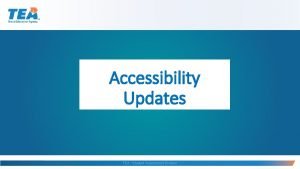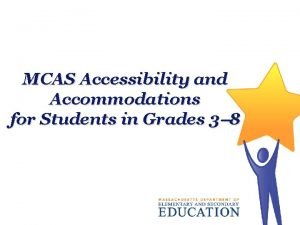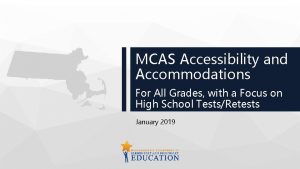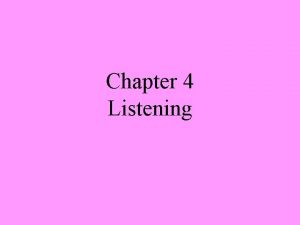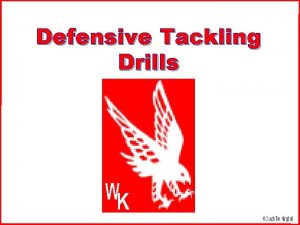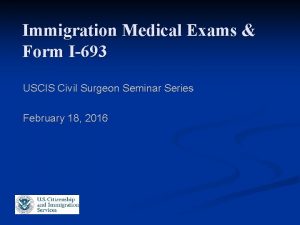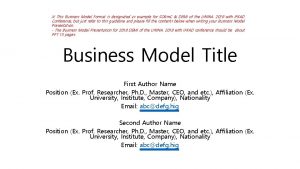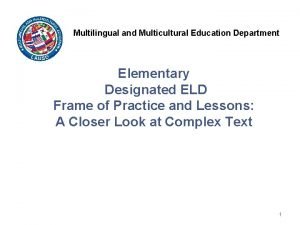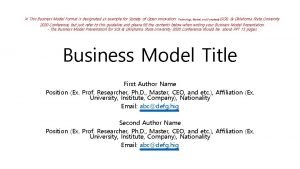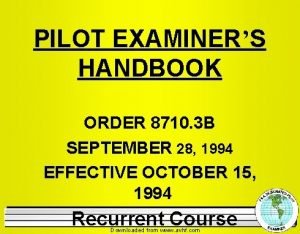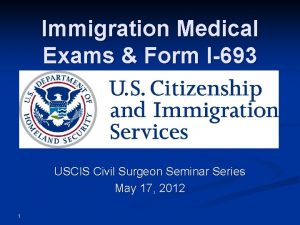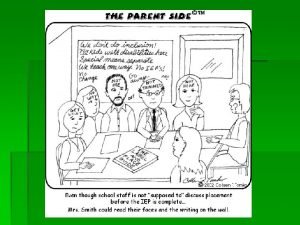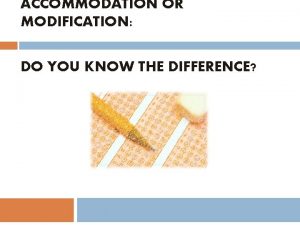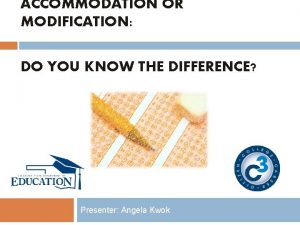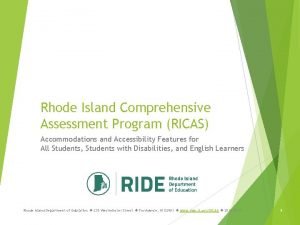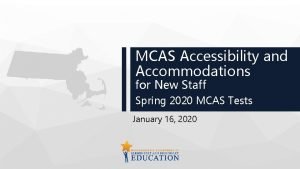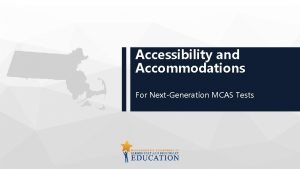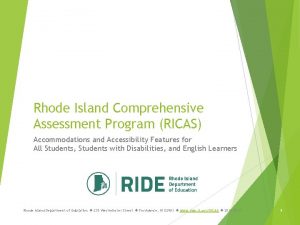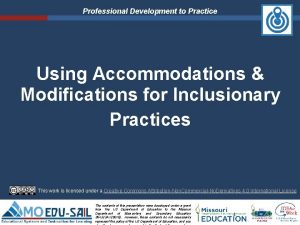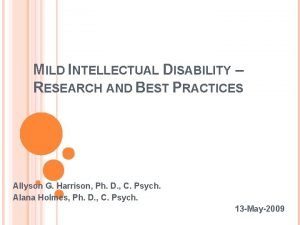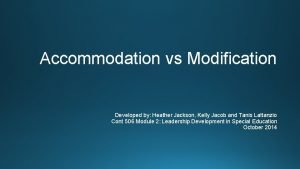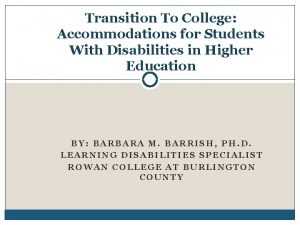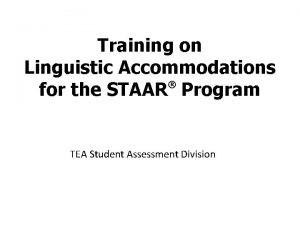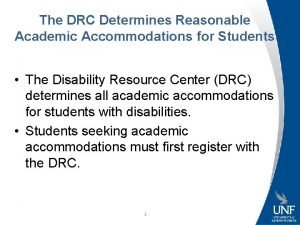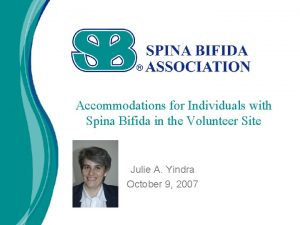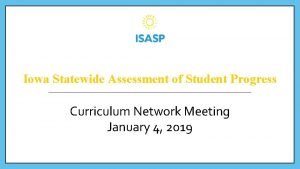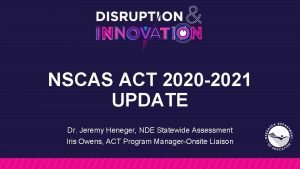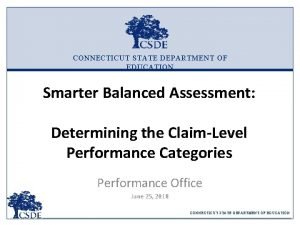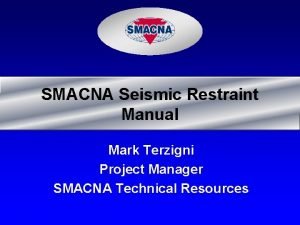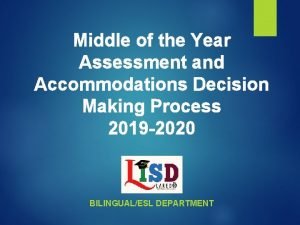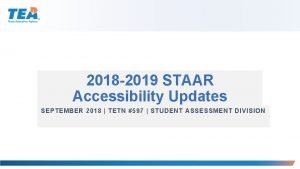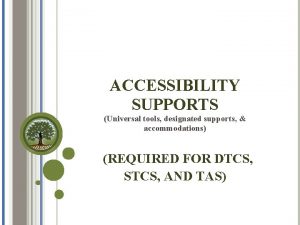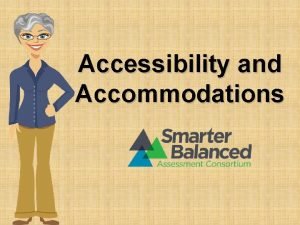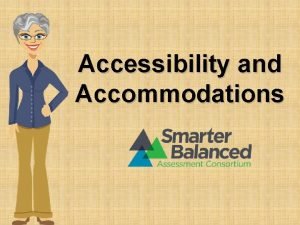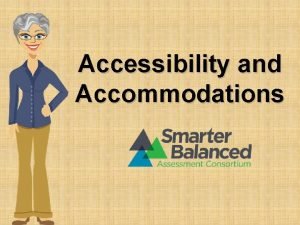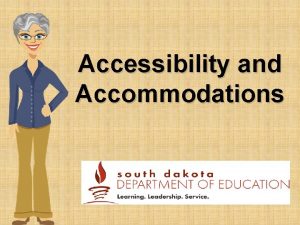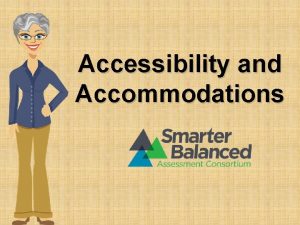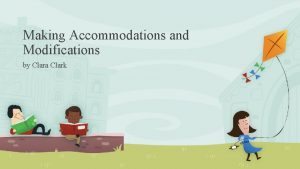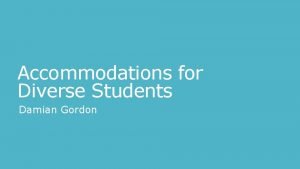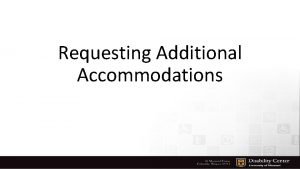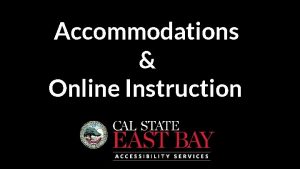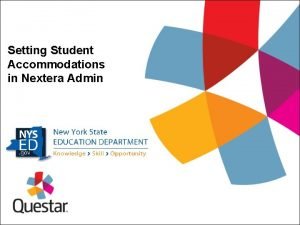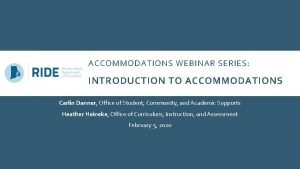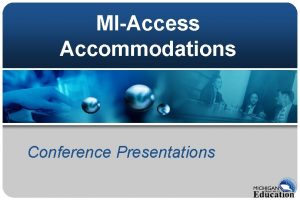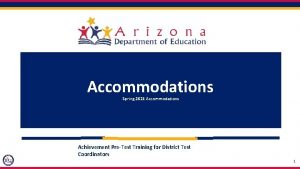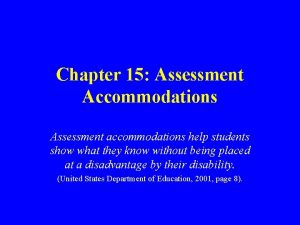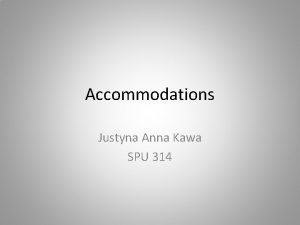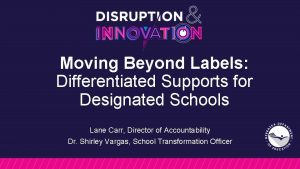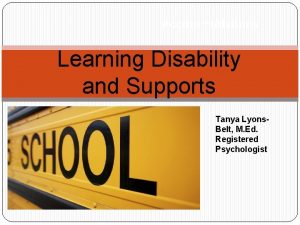Utilizing Universal Tools Designated Supports and Accommodations in











































- Slides: 43

Utilizing Universal Tools, Designated Supports, and Accommodations in Daily Classroom Practice TOM TORLAKSON State Superintendent of Public Instruction

Session Overview • Review available accessibility supports • Review the Individual Student Assessment Accessibility Profile (ISAAP) process • Match student learning characteristics to available supports • Connect to classroom practice • Analyze classroom data California Department of Education 2

Learning Goals Participants will understand • the California Assessment of Student Performance and Progress (CAASPP) accessibility support categories; • how the accessibility supports connect to classroom instructional learning supports; • how accessibility supports can be used to improve classroom teaching and learning; and • how to match individual student learning characteristics/needs to accessibility supports in the classroom. California Department of Education 3

Success Criteria Participants can • describe the range of accessibility features available through the CAASPP system; • compare classroom instructional learning supports and CAASPP accessibility supports; and • appropriately match individual student learning characteristics/needs to accessibility supports for classroom use. California Department of Education 4

Time to Think and Share • How do you meet individual student learning needs during daily classroom instruction? • • • Explicit/direct instruction Teacher guided instruction Collaborative work Independent work Classroom assessment (formative, interim, or summative) California Department of Education 5

Classroom Support • What specific strategies/techniques do you use to meet the needs of students with these learning characteristics? • Struggling reader • Attention difficulties • English language learner • Special education student California Department of Education 6

Purpose and Importance of Accessibility Supports Ensure equal opportunity for all students to demonstrate learning: • During daily instruction • On classroom assessments • On Smarter Balanced assessments (both Summative and Interim) California Department of Education 7

Use of Accessibility Supports General guidelines for use of all accessibility supports on Smarter Balanced assessments and California Alternate Assessments (CAA): • Student is familiar with the support(s) • Supports are the same or similar to those used for instruction and classroom assessment • Student has multiple opportunities to practice with the support in a testing environment California Department of Education 8

2016— 17 Accessibility Supports in California

CAASPP Accessibility Universal tools • Available to ALL students. Designated supports • Available to ALL students, with a documented decision made by an adult who knows the student Accommodations • Available to students with Individualized Education Programs (IEPs) and Section 504 Plans 10

Categories of Accessibility Support Accessibility supports generally address needs that fall into these categories: • Presentation • Response • Timing/Scheduling • Setting 11

Accessibility Supports Activity • Review the graphics on the next three slides listing the CAASPP accessibility supports. • As you review the available supports, notice which include variation in presentation, response, timing/scheduling and/or setting. • Highlight any tools with which you are not familiar. California Department of Education 12

California Department of Education 13

California Department of Education 14

Smarter Balanced Item Types and Accessibility Features • Embedded Universal Tools, Designated Supports, and Accommodations Video Tutorials http: //www. caaspp. org/training/caaspp/uaag. html • Smarter Balanced Item Types and Accessibility Features document http: //www. smarterapp. org/documents/Item_Types_And_Features. pdf • Smarter Balanced Accessibility Consortium: Usability, Accessibility, and Accommodations Guidelines • Tables 1 -6 describe available supports https: //portal. smarterbalanced. org/library/en/usability-accessibility-andaccommodations-guidelines. pdf California Department of Education 15

reflect • To what extent are administrators and teachers in your local educational agency (LEA) familiar with the range of available accessibility supports? • To what extent do they know how each of the supports works? • What might be the next action steps to strengthen knowledge of the available accessibility supports in your LEA? California Department of Education 16

Use of Accessibility Supports • A thoughtful systematic process across the LEA necessary to identify and address identified student needs: • Consistently • Equitably • Appropriately • Effectively California Department of Education 17

ISAAP Process 1. Designate key staff roles and responsibilities. 2. Provide information to parents and training to staff. 3. Identify students who will benefit from designated supports and students who will require accommodations per IEPs and Section 504 Plans. 4. Select the designated supports and accommodations for all identified students. California Department of Education 18

ISAAP Process (cont. ) 5. Enter the selected designated supports and accommodations into the Test Operations Management System (TOMS). 6. Perform a pre-administration check of assigned accessibility supports. 7. Check for delivery of assigned supports and accommodations at the time of the test. California Department of Education 19

Using Accessibility Supports to Improve Teaching and Learning

Special Education and Section 504 Plans • IEP teams and/or Section 504 teams are responsible for the following: • Identifying individual learning needs of students with active IEPs or Section 504 Plans • Selecting appropriate designated supports and/or accommodations to meet those needs • Including that information in student plans • Supporting and monitoring implementation of selected supports in daily instruction and on assessments California Department of Education 21

Identifying Student Needs • How are individual student learning characteristics and learning needs identified at the classroom level? • How do teachers determine which students need additional learning supports in order to fully access instruction and accurately demonstrate their learning? California Department of Education 22

Matching Needs to Supports • Classroom pedagogical strategies/techniques • Universal tools • General • Targeted • Designated supports • Accommodations California Department of Education 23

Identification-Selection Process California Department of Education 24

Smarter Balanced Resources and Practices Comparison Crosswalk http: //www. smarterbalanced. org/wordpress/wp-content/uploads/2014/03/Smarter. Balanced-Resources-and-Practices-Comparison-Crosswalk 1. pdf California Department of Education 25

Connecting Needs with Classroom Supports • Jorge, an English learner • Kristie, a student with a reading disability (Specific Learning Disability) • Jennifer, a student with attention issues California Department of Education 26

Learning Profiles Activity • Review the learning profiles for each of the students. • Using the crosswalk document, identify appropriate accessibility supports for each student including at least one targeted universal tool and one designated support for each student. For Kristie, you may also choose an accommodation. • Be prepared to share the Smarter Balanced features you choose, along with the classroom pedagogical practice aligned with that feature. California Department of Education 27

Connecting Supports to Individual Student Needs • What student learning characteristics might be supported through use of the following supports? • Masking • Stacked translation • Zoom • Color contrast • Multiplication table • How would you translate that support into classroom practice? California Department of Education 28

Activity: Connecting Supports to Student Needs • For the remaining three accessibility supports on the previous slide (zoom, color contrast, multiplication table), answer the following questions: • What student learning characteristics might be supported through the use of this accessibility feature? • How would you translate that support into classroom practice? California Department of Education 29

Decision-Making Cycle California Department of Education 30

reflect • In what ways might you increase the effective, appropriate use of accessibility supports in daily instruction in your LEA to enhance teaching and learning for all students? • What actions would need to be taken to achieve that? • How can you use the Resources and Comparison Crosswalk to encourage and support teachers to connect current classroom instructional practices to the accessibility tools? California Department of Education 31

Practice Tests and Training Tests California Department of Education 32

Benefits of Using Accessibility Supports in the Interim Assessments • Accessibility supports are modifiable in the Test Administrator Interface for the Smarter Balanced Interim Assessments. • They provide additional opportunities for students to try out accessibility supports on actual test items and for teachers to observe and talk with students to evaluate their effectiveness. California Department of Education 33

Classroom Data • Document the student’s use of supports during daily instruction and on classroom assessments • Analyze data on student performance with and without targeted supports. Ask questions such as: • What was the impact of the use of specific supports on student performance? • Are more time and practice needed? • Was the support or group of supports a distraction? California Department of Education 34

Monthly Tracker California Department of Education 35

Student Input • Obtain student input via interviews after practice opportunities: • Which accessibility supports were used? • Were there any problems with the supports? • Should the support(s) be used again? California Department of Education 36

Student Interview Form California Department of Education 37

Collaborative Journal California Department of Education 38

reflect • To what extent are students being directly taught how to use supports? • To what extent are students using similar supports in daily classroom instruction? • To what extent are students being provided with multiple opportunities to practice using the selected accessibility supports in the testing environment? • What are possible next action steps in your LEA to support the effective, appropriate use of CAASPP accessibility tools to enhance teaching and learning for all students? California Department of Education 39

Effective Student Use of Accessibility Supports http: //www. cde. ca. gov/ta/tg/sa/documents/suggestedtimeline. pdf California Department of Education 40

Usability, Accessibility, and Accommodations Guidelines http: //www. cde. ca. gov/ta/tg/sa/access. asp California Department of Education 41

Accessibility Resources • CDE’s Student Accessibility Supports Web page: http: //www. cde. ca. gov/ta/tg/ca/accesssupport. asp • Smarter Balanced Accessibility and Accommodations Web page: http: //www. smarterbalanced. org/parents-students/support-forunder-represented-students/ California Department of Education 42

Thank You! California Department of Education 43
 What are accessibility features for staar
What are accessibility features for staar Mcas universal accommodations
Mcas universal accommodations Ma dese mcas accommodations
Ma dese mcas accommodations Tuning out dull topics
Tuning out dull topics Football pursuit drill
Football pursuit drill Site:slidetodoc.com
Site:slidetodoc.com Usfws designated ports
Usfws designated ports Designated civil surgeon locator
Designated civil surgeon locator Designated format
Designated format Integrated eld vs designated eld
Integrated eld vs designated eld Designated teacher training
Designated teacher training Jcids manual
Jcids manual Designated eld lesson plans
Designated eld lesson plans Designated regional office of utiitsl
Designated regional office of utiitsl Designated format
Designated format Designated pilot examiner handbook
Designated pilot examiner handbook Civil surgeon near me
Civil surgeon near me Accommodations and modifications
Accommodations and modifications Accommodations for speech and language impairment
Accommodations for speech and language impairment Difference in accommodations and modifications
Difference in accommodations and modifications Accommodation vs modification
Accommodation vs modification Rhode island
Rhode island Mcas supplemental reference sheet
Mcas supplemental reference sheet Mcas accommodations
Mcas accommodations Mcat accommodations personal statement example
Mcat accommodations personal statement example Ricas math
Ricas math Types of accommodations
Types of accommodations Types of accommodations
Types of accommodations Borderline intellectual functioning
Borderline intellectual functioning Accommodations vs modifications chart
Accommodations vs modifications chart Accommodations in college
Accommodations in college Staar
Staar Drc accommodations
Drc accommodations Accommodations for students with spina bifida
Accommodations for students with spina bifida Types of reasonable accommodations
Types of reasonable accommodations Isasp practice writing
Isasp practice writing Nebraska act test dates
Nebraska act test dates Sbac accommodations ct
Sbac accommodations ct Smacna seismic restraint manual
Smacna seismic restraint manual Oral administration staar 2020
Oral administration staar 2020 What are content and language supports
What are content and language supports Structured guidance and supports
Structured guidance and supports Staar content and language supports
Staar content and language supports Metacognition and growth mindset supports grit.
Metacognition and growth mindset supports grit.
